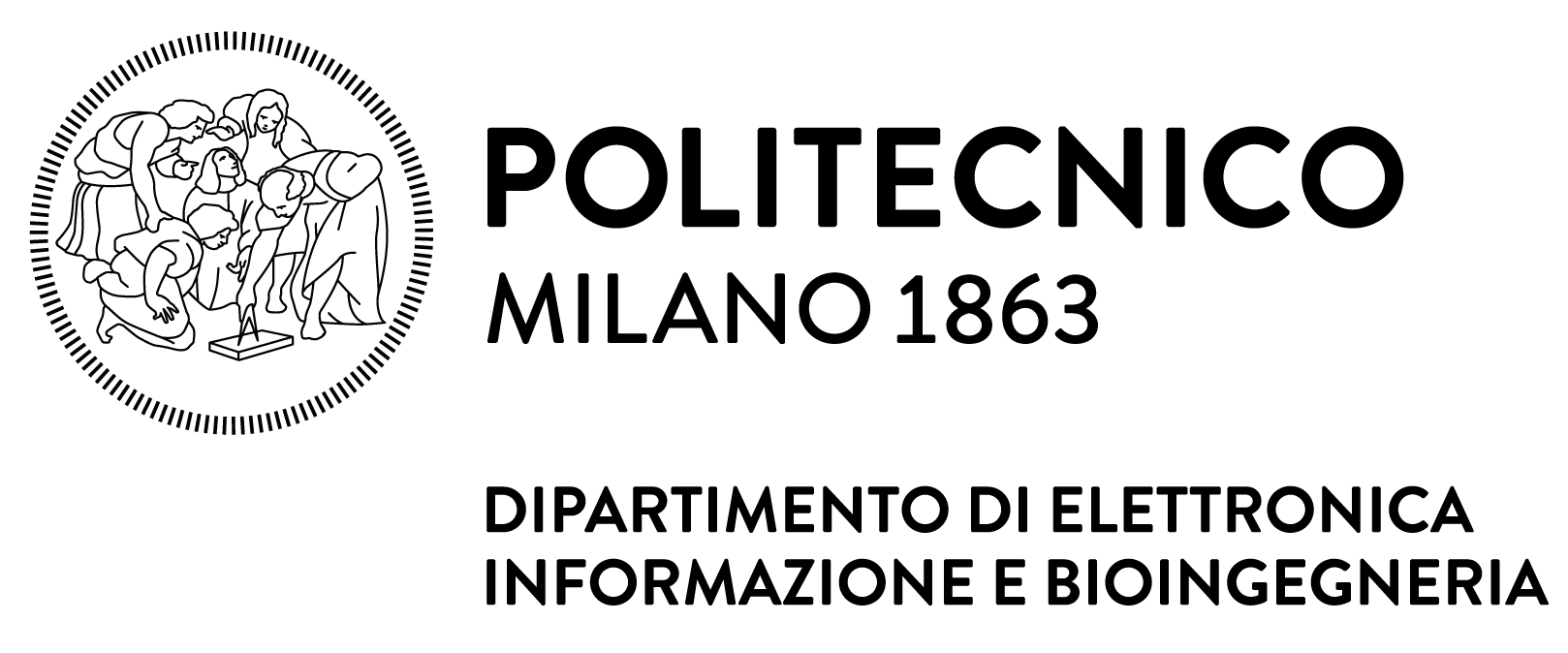Tourism in Milano
GUIDED TOURS (Let us know what you like best and we’ll organize a tour for you!)
Hey, once you are in Milano, you might wish to consider visiting Venice, and/or Florence, and/or Rome. Venice and Rome do not need any advertising. As for Florence, this is the city of Leonardo da Vinci, the religious fanatic Savonarola (who governed Florence for five years and had books and art publicly burned during his tenure; was repeatedly summoned by the Borgia pope to be judged for blasphemy and similar sins; was finally hanged and burned, but in Florence itself since the governing body of the city wanted it so, not in Rome), of Machiavelli, of the Medici dynasty of politicians (and, later on, also popes), where Brunelleschi built a big double dome for the unfinished Florence cathedral (without the use of a prohibitively large scaffolding, an innovation unheard of at the time), etc. All that in just in the 15th century.
The cultural treasures that Florence has to offer can make you gasp in admiration at the achievements of the human spirit and the vast heritage of the Renaissance in Europe. Florence is so artistically rich that, if not careful, you might acquire the psychosomatic disorder that affects some people from exposure to so much art. It is called the Florence or Stendhal syndrome. This prominent French essayist and novelist wrote after visiting the town in 1817: “I was in a sort of ecstasy, from the idea of being in Florence, close to the great men whose tombs I had seen. Absorbed in the contemplation of sublime beauty. I reached the point where one encounters celestial sensations. Everything spoke so vividly to my soul”. Michelangelo, Masaccio, Rafaello, Donatello and Botticelli are just a few of the names you will read under the breathtaking masterpieces.
Don’t be shy. Just ask for your preferred sites to visit. Chances are that other participants may ask for the same topics, so personalized tours can be arranged! Nevertheless, below are a few tours you can choose from when in Milano.
-
#1 Sforza Castle
Sforza Castle (Italian: Castello Sforzesco) was built in the 15th century by Francesco Sforza, Duke of Milan, on the remnants of a 14th-century fortification. Later renovated and enlarged, in the 16th and 17th centuries it was one of the largest citadels in Europe. Extensively rebuilt by Luca Beltrami in 1891-1905, it now houses several of the city’s museums and art collections, including the Egyptian Section of the Milan Archaeological Museum , the Museum of Ancient Art, the Pinacoteca (with an art collection which includes Andrea Mantegna’s Trivulzio Madonna and masterpieces by Canaletto, Tiepolo, Vincenzo Foppa, Titian and Tintoretto), and the Museum of Musical Instruments. -
#2 The Pietà Rondanini
The Rondanini Pietà is the last incomplete work by Michelangelo Buonarroti (1475-1564). The Pietà is a meditation on death and the salvation of the soul. In this work the sculptor discards the perfection of the human body and its heroic beauty and transforms the dead Christ into an emblem of suffering. The physical arrangement of Mary and Jesus, the mother’s head above that of the son, is suggestive of various moments of the life of Christ: the deposition from the cross; the burial and even the resurrection: in the dissolution of Christ’s body in the mother’s embrace. Left incomplete due to the death of Michelangelo, the Pietà is a testament to the last period of the great master’s creative genius (see more below). -
#3 Sala delle Asse
A remarkable record of the presence of Leonardo da Vinci (1452-1519) at the Sforza Court, the Sala delle Asse (Room of Wooden Boards) is the most iconic room in the Sforza Castle. The room owes its name to the wooden wall covering that was used at the time of the Sforzas to render the temperature and ambience of the rooms more comfortable. Formerly painted with heraldic motifs for Galeazzo Sforza, under Ludovico il Moro in 1498 it was transformed by Leonardo’s renowned decoration. Situated on the first floor of the Falconiera tower on the north-east corner of the castle, the Sala delle Asse is Room VIII of the Museum of Antique Art. -
#4 Highline Galleria
Highline Galleria path suspended along the rooftops of Galleria Vittorio Emanuele II. A 250 meter path that allows you to touch the dome of the Galleria with one hand and the the sky with the other, leaving you fascinated by a 360 degree view over Milan and the surrounding Alps. An exciting path but also a place rich of events and initiatives where you could taste a fantastic aperitif, a funny lunch and memorable dinner. -
#5 As You Like It
If you like something else, please have a look below and let us know your prioritized preferences when you register yourself for 2018 ACSGAKC. We’ll try to organize a tour just to match your preferences!
A glance at Milano
Milano comes from the latin name Mediolanon (ancient Greek) or Mediolanum (Latin), meaning a city in the middle of the flat land, or, a city located between the waterways. Located in the Po Valley, between Turin (W) and Venice (E), the Alps, or the main European mountain chain (N), the Apennines and the coast of Ligura (S), Milano is surrounded by enchanting scenarios of flat lands, riversides, the lakes Como and Lecco, hills and picturesque towns and places. Founded by the Celts in 400 B.C., the Romans gave it the name Mediolanum, meaning “in the middle of the lands”. Because of its geographic location, since the beginning it has been one of the most international cities of Italy, a natural crossroad between the Nordic and the Mediterranean cultures. Signs of the History are still visible in the amazing old districts, besides a great heritage of art and architecture. Milestones as the Brera Altarpiece by Piero della Francesca, The Last Supper by Leonardo da Vinci, The Marriage of the Virgin by Raphael, the Rondanini Pietà by Michelangelo, can be seen in the city museums, while many modern masterpieces can be observed at the Triennale di Milano, at PAC and in several other institutions. Historical Libraries as the Ambrosiana and the Braidense, or the National Museum of Science and Technology can be visited, while architectural monuments, like Duomo (Cathedral) and Duomo Museum, Castello Sforzesco (Castle), the Church of S.Maria presso San Satiro can be reached or simply seen walking through the city center. Teatro della Scala is one of the worldwide symbols of the Opera. But Milano is also the Italian capital of Fashion and Design, holding many events during the year. Parks, hotels, restaurants and places for entertainment richly populate the city. Always moving, the face of Milano is changing again, and after the big exhibition pavilions of Rho Fiera, the new modern district of City Life, designed by Arata Isozaki, Deniel Libeskind and Zaha Hadid, is rising up within many other buildings and infrastructures. Among the big, worldwide events recently hosted in Milan, EXPO 2015 has to be mentioned. This video, “36 Hours – The New York Times – What to Do in Milan”, by Ingrid K. Williams, provides a lively picture of Milano business, art, and culture.
The few monuments you can’ miss:
- Roman – The columns of St. Lorenzo Basil
- Middle Ages, Romanic – St. Ambrogio Basil, The Merchants’ Square
- Middle Ages, Gothic – The Cathedral
- Renaissance – The Church of “Santa Maria alle Grazie” (the Last Supper is nearby)
- Neoclassic – The Opera House “La Scala”
- Modern – The Pirelli Tower (in front of the Central Station)
- Contemporaneous – The Directional Centre around Gae Aulenti square
Important tips:
- Book your visit to Leonardo’s Last Supper well in advance (Official booking site). Last Supper booking for July opens April 19 and it’ likely to be rapidly sold-out.
- The Opera House “La Scala” is ending its season on July 19th (ballet). Nonetheless, any day (9AM – 5:30PM) you can visit the Museum and admire the theatre from a box (loge).
- To discover Milano Google “Visit Milan“
- For the surrounding area, which embraces many beautiful ancient towns, lakes, and the Alps, Google “Day trips from Milan“
Michelangelo, Raffaello, and Leonardo in Milano:
The Signature of Complexity in Sublime Imperfection
The perfection of work of arts reflects the perfection of human body and mind expressed by the artist. However, imperfect works can give us a breakthrough in the complexity hidden behind. You will find three marvelous examples in Milano: two by Michelangelo and Raffaello, almost unknown, the third one by Leonardo,
most celebrated.
Michelangelo’s “Pietà Rondanini” – Holism
The young Michelangelo had already reached perfection by the renown “Pietà” of the Vatican.
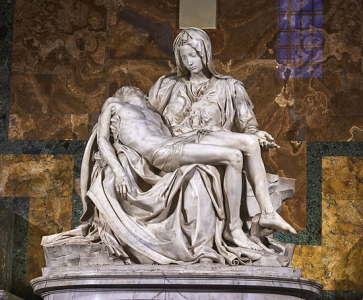
The marble he personally selected in the mountains over Carrara (Tuscany) was shaped to live and silent sorrow, to the dereliction of
death, and the gentleness of vests, which makes it a world’s masterpiece.
It’ hard to believe that Michelangelo had more to say in this very subject, but he did by the “Pietà” in Florence and next by the “Pietà Rondanini” in Milano: a life-long, dramatic travel to imperfection, from his first masterwork to the last one.
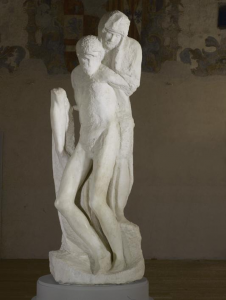
You can see the “Pietà Rondanini” at the “Sforza” Castle (Castello Sforzesco) and the contrast with the former “Pietà” will strike you. Michelangelo worked intermittently on it over more than a decade. He conceived a daring vertical composition and when it was almost at the end, after two years, he completely turned it within the same piece of marble, as only he was able to do (see the Moses). But he never finished. As a result, we can simultaneously admire the finished and the unfinished (see the Prisoners). The power of his mind over raw matter comes out revealing the imagination, the doubts, the suffering of creation hidden in his first Pietà.
Might this be a paradigm of a holistic approach to complexity in Life Sciences?
Raffaello’s Preparatory Cartoon of the School of Athens – Reductionism
Who does not know Raffaello’ most famous fresco in the Vatican rooms: the lively and colorful representation of the intellectual life of Renaissance through the Greek philosophers?
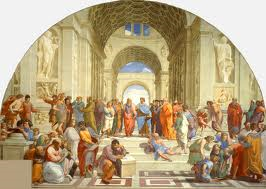
Conversely, very few do probably know the preparatory cartoon to be admired at the “Ambrosiana” Library and Gallery (site also of Leonardo’s Atlantic Code).
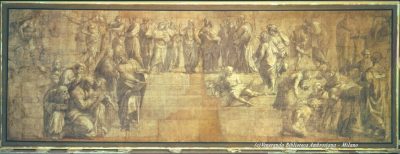
However, even if color is missing, Raffaello’s genius jumps to your eyes and you see his creative process, which in the finished artwork is astonishing.
Might this be a paradigm of a reductionistic approach?
Leonardo’s Last Supper – Always Problems with Methods and Technology
Leonardo kept the same sublime and unique painting style along his entire life. But he was also curious about natural sciences and technology, which made him kaleidoscopic talent. The mix, however, gave him several troubles in the art of fresco painting, since he wanted to deal with new color techniques and artistic creativity at the same time. Furthermore, he hated the immediacy of fresco work, where the painter must be more rapid than the drying cement on the wall. His experiments led him to disaster in Florence (see The Battle of Anghiari, lost fresco) and almost to, concerning the Last Supper. In fact, the masterpiece immediately started fading and nowadays, after a challenging restoration, it is kept much like in a hospital ICU. Only few visitors are admitted at a time in a strictly conditioned ambient. For this reason, you should book your visit several months ahead. Don’t miss it.
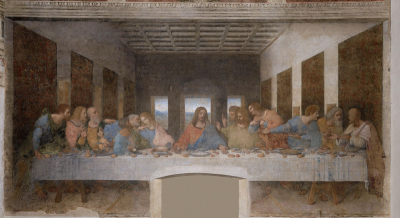
Territorial Conclusion
In case the reader came to the conclusion that in Milano we do have mainly defective items, while all the polished ones are elsewhere (Rome, Florence, Venice, Paris, etc.) he or she might be absolutely right. Nonetheless, we are very proud of them, wishing to show the sublimity of imperfection, as a true paradigm of human complexity.
UNFORGETTABLE TOURIST INFORMATION:
Some hints for wonderful sightseeing
Chatedral “Duomo di Milano”
Castle “Castello Sforzesco”
Museum “Pinacoteca di Brera”
“Basilica di Sant’Ambrogio”
Masterpiece of Leonardo da Vinci, The Last Supper
“Galleria Vittorio Emanuele II”
“Palazzo Reale”
Museum “Museo del Novecento”

